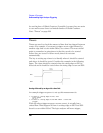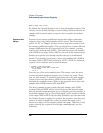
197
Chapter 4: Concepts
Understanding Logic Analyzer Triggering
analyzer will never trigger.
When the conditions are met in a sequence level, it is clear which
sequence level will be executed next when a “Go To” action is used, but
it is not necessarily clear if there is no “Go To”. On some logic
analyzers, if there is no “Go To”, this means that the next sequence
level should be executed. On other logic analyzers, it means the same
sequence level should be executed again. Because of this confusion, it
is good practice to always use a “Go To” action rather than relying on
the default. The new Agilent Technologies 16715/16/17/18/19A state
and timing modules deal with this problem by automatically including a
“Go To” or “Trigger” action in every sequence level. For example:
If ADDR = 1000 and DATA = 2000 then
Go to 1 <- This is automatically added on the Agilent 16715/16/17/18/19A
Next: “Boolean Expressions” on page 197
Boolean Expressions
While multiple sequence levels imply a “followed by”, within a
sequence level Boolean expressions can be used. An example is:
If ADDR = 1000 and DATA = 2000
This expression means that for this expression to be met, ADDR must
equal 1000 in the same sample that DATA equals 2000. In other words,
ADDR equals 1000 at the same time that DATA equals 2000. Therefore,
if you want to trigger on two events that occur at the same time, a
Boolean expression should be used.
It's a common mistake to try to use two sequence levels when a
Boolean expression should be used or to use a Boolean expression
when two sequence levels should be used.
NOTE: Boolean expressions are used for events that happen at the same time, and
multiple sequence levels are used when one event follows another.
Next: “Branches” on page 198


















